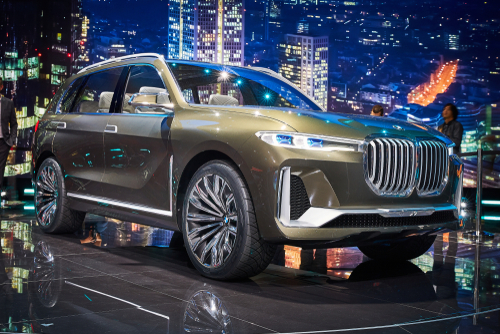A sneak peek at the 2019 BMW X7, a year ahead of its public release
How big is BMW’s new X7 sport activity vehicle? The auto maker isn’t saying exactly, but here’s a clue: I drove 250 kilometres through South Carolina tucked into the middle of a convoy of camouflaged X7s following a small red lead vehicle that I blithely believed to be an X4 – i.e. BMW’s compact sport activity coupe.
Only when I eventually parked behind the little red job at the lunch stop did I realize it was an X6 – the mid-size big sister of the X4. It looked so small compared with the X7s trailing in its wake.
It’s no secret that BMW is planning its first foray into the full-size SUV market with the X7. The company has been on the record about it since March, 2014. It showed a lightly disguised “concept car” teaser version at the Frankfurt auto show last September.
Yet even now, after our advanced “predrive” of X7s near the Spartanburg, S.C., plant where it will be built, we still don’t have a lot of details. This wasn’t your standard test drive. The X7s were very early preproduction samples, covered in a camouflage wrap. No tech specs were provided. Multiple engineers were on hand for interrogation, but they weren’t allowed to share details.
Yes, they told us, the engines are more powerful and more fuel efficient. How exactly was that achieved? Sorry, can’t tell you that yet.
Although the iPerformance auto-show concept was presented as a plug-in hybrid, the X7 will launch initially with updates of the 3.0-litre, in-line six-cylinder and 4.4-litre, V-8 turbo engines familiar from many other BMW models. The eight-speed automatic transmission and xDrive AWD system will likewise be optimized updates of familiar hardware.
A hybrid version will follow, as will a 3.0-litre turbo diesel, though the latter may not be offered in North America.
What took BMW this long to enter this lucrative segment? In part, head of project Dr. Jorg Wunder told me, it’s because BMW’s top decision makers were uncertain if there was sustainable demand for such a product; the oil shock and the 2008 great recession were cause for pause.
As well, Wunder says, “They asked themselves if such a vehicle could still drive like a BMW.”
My first clue that BMW may have resolved that dilemma is when Wunder points to the engineer he describes as “the father” of the X7’s chassis. Christoph Stefan – full title: product engineering, driving dynamics BMW X7 – is tall, skinny and looks too young to be a father. What he does look like, however, is a young enthusiast who you can’t imagine would engineer an old man’s car.
Before we put that to the test, be aware that Stefan’s work isn’t done yet. Wunder says the chassis is about 80 to 85 per cent there.
Indeed, part of the reason for this press-drive exercise is to get feedback to help BMW finalize the set-up. The hardware is fixed but there’s still time to tweak the programming of the computers that control the electric power steering and adaptive dampers (standard on all trims) as well as options such as height-adjustable air suspension, four-wheel steering and active stabilizer bars.
Add all those variables to the three select-drive modes (eco pro, comfort and sport) and the question “How does it handle?“ evokes the response “How long is a piece of string?” Still, the overriding impression is of a truck built for drivers. Huge tires (wheel sizes range from 20 to 22 inches) provide serious grip. The ride is comfortably taut and – perhaps amplified by the coarse texture of South Carolina paving – there’s ample road feel.
BMW even sent us through the Gulches off-road vehicle park, where the X7s seamlessly negotiated a hilly course of gullies and berms that would hardly challenge a Land Rover but that few owners would ever inflict on their own SUVs. Even with the air suspension topped out (40 mm above normal), the X7 doesn’t look especially high-riding, but it kept its bottom clean.
What would I change? The steering feel. Even in comfort mode, it’s quite firm, with what feels to me like artificial resistance rather than natural heft. Of course, engaged drivers don’t want steering that’s too light, but I prefer the pin-sharp, frictionless steering feel of, say, modern Jaguars and Cadillacs.
As for powertrains, the 3.0-litre gasoline and diesel six-pots both handle the X7’s roughly 2,300-kilogram heft with authority, with the charismatic 4.4-litre, twin-turbo V-8 as the cherry on top. With engines that sound this musical, be glad BMW didn’t try to dumb them down into silence.
The inside story is incomplete, as parts of the décor were covered over and we weren’t allowed to try the third-row seat on for size. The driver gets enough adjustability at the wheel to allow commanding visibility, and the switchgear is user-friendly, with knobs and buttons for the most-used audio and HVAC controls. Like some Mercedes cars, the X7 has two 12.3-inch screens – one for the main gauge cluster, the other for the infotainment/connectivity/telematics – but unlike its rival, BMW creates a separation between the two, with the gauge display in a conventional binnacle.
In the second row of various X7s, I sampled both bench and bucket seats, all four-way power adjustable. Even with the seats fully back, legroom was hardly expansive, but that also left what looked like usable legroom in the third row.
Bums-in-seats confirmation of that will have to wait for the official first-drive preview event late this year or early next. The X7 will go on sale in the first quarter of next year. It’s going to be big.

